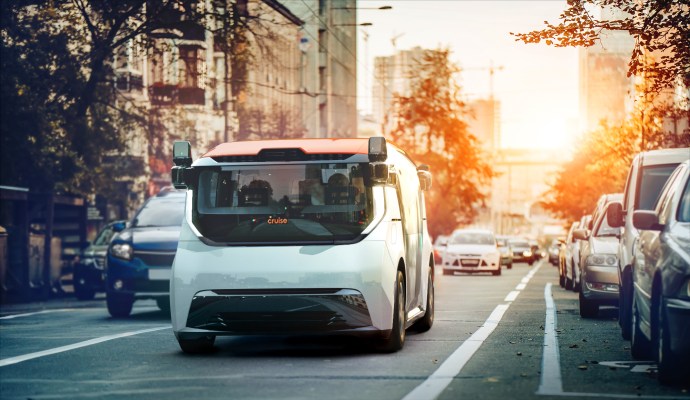Cruise CEO Kyle Vogt said Thursday at an investor conference that the company is close to from getting the green light to begin mass production of its purpose-built autonomous vehicle without a steering wheel or pedals.
“We’re testing it and we are, from what we’ve heard from [the National Highway Traffic Safety Administration], just days away from the last regulatory approval, which would let us start production and almost immediately start putting these vehicles on the road,” Vogt said at a Goldman Sachs event.
NHTSA told TechCrunch that no decision to grant or deny GM’s petition has been reached, nor has a deadline been set for such a decision. That said, federal safety regulators are expected to announce a new rule-making in September. If passed, it also will benefit Amazon’s Zoox, which has built and is testing a similar type of vehicle to Cruise’s Origin.
Cruise first unveiled its Origin AV — built for both autonomous ride-hail and delivery — in early 2020. The GM-backed company has promised to put “tens of thousands” of Origins on streets in major U.S. cities over the next few years, but its ability to begin mass production has been hampered by lengthy regulatory processes.
Cruise, via GM, has been waiting for an exemption from the federal government’s motor vehicle safety standards, which require vehicles to have a steering wheel and pedals. NHTSA only grants 2,500 such exemptions each year, but there is legislation to increase that number to 25,000.
Cruise has still been testing its Origins in cities where it operates like San Francisco and Austin.
Vogt’s announcement comes a few weeks after one of those test vehicles drove off the road and into a small electrical building, according to Austin Transportation Department records obtained by Axios. The Origin hit the building with enough force to break some off, the report said. Because the vehicle had no steering wheel, emergency personnel couldn’t quickly move it, and had to wait for a tow truck.
Cruise said the Origin test vehicle had experienced a system fault during testing and pulled over safely, but when live support re-engaged the vehicle, it shifted out of park and rolled into the building at six miles per hour.
Much of Cruise’s ability to score regulatory approval will depend on how the company answers questions regarding the safety of its vehicles that are already on the road.
Today, Cruise operates fleets of Chevy Bolt AVs in San Francisco, Austin and Phoenix, with plans to expand to a handful more cities. The company has come under the microscope in its hometown of San Francisco, where it operates around 400 robotaxis, after a string of incidents of stalled vehicles that have caused traffic jams and blocked emergency responders. The California Department of Motor Vehicles asked Cruise to reduce its fleet size after one of its vehicles collided with a fire truck, injuring one passenger. This happened days after Cruise, and its competitor Waymo, had received final approval to expand commercial, fully autonomous services across the city 24/7.
Earlier this week, protestors rallied outside of Cruise headquarters after the fire department accused the company of allowing its robotaxi to block the path of an ambulance which carried a passenger who later died. Cruise showed footage of the incident to TechCrunch that backed its denial of the incident as the fire department described, but the company suffered a reputation hit anyway.
While speaking at the investor event, Vogt expressed concern that too much pushback against the robotaxis — simply for being pioneer technology that will make mistakes — will stall important technological advancements that could make roads safer and save lives.
“I worry that we’re going to set society back a decade when it comes to road safety,” he said. “That’s just something we can’t do.”
Building cheaper AVs for better unit economics
Vogt noted that while the Origin is designed to be “a party on wheels” or a “Zen oasis between meetings or on your way to work,” it’ll also present an opportunity to build more vehicles at a cheaper cost.
The executive and Cruise founder said the Origin costs GM less to build than its Chevy Bolts because all of the sensors, compute systems and software are simplified to lower the upfront cost of the vehicle. And in a few years, the Origins will rely on Cruise’s custom, in-house designed chips, which Vogt says takes a lot of cost and complexity out of the equation.
“Working closely with GM, we’ve done a lot of work to increase the lifespan of this vehicle,” said Vogt. “An average car has maybe 150,000 miles, 200,000 miles, something in that range. The Origin is designed to last 1 million…and so you put that long lifetime, lower upfront cost together, that’s a dramatic reduction in the cost per mile to operate these vehicles, which is a key unlock for profitability.”
Vogt went on to say that once the Origin goes into production, it can scale very quickly. He declined to provide a timeline or capacity at GM’s plant.
“We have a great deal of precision around both the final cost of this and the timing, which means that in 2025, the hardware we build will be capable of reaching those unit economics,” said Vogt, reiterating Cruise’s goal of getting down to a cost of operating at $1 per mile.
Cruise has stated its goal of reaching $1 billion in revenue by 2025, a target that Vogt said the company is on track to hit and one that might even help Cruise finally break even. That is, if Cruise can start mass-producing its cheaper Origin vehicles, scale to new markets, and operate more vehicles at more hours of the day.
This article has been updated with more information about Cruise’s plans to scale the Origin and reach better unit economics.
